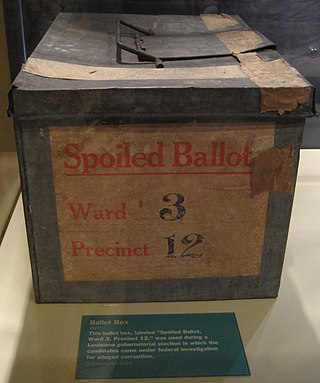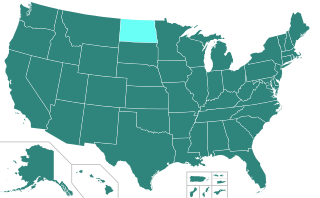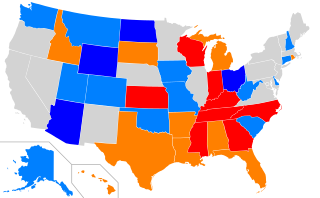
A protest vote is a vote cast in an election to demonstrate dissatisfaction with the choice of candidates or the current political system. Protest voting takes a variety of forms and reflects numerous voter motivations, including political apathy. Where voting is compulsory, casting a blank vote is available for those who do not wish to choose a candidate, or to protest. Unlike abstention elsewhere, blank votes are counted.

In political science, voter turnout is the participation rate of a given election. This is typically either the percentage of registered voters, eligible voters, or all voting-age people. According to Stanford University political scientists Adam Bonica and Michael McFaul, there is a consensus among political scientists that "democracies perform better when more people vote."
An election exit poll is a poll of voters taken immediately after they have exited the polling stations. A similar poll conducted before actual voters have voted is called an entrance poll. Pollsters – usually private companies working for newspapers or broadcasters – conduct exit polls to gain an early indication as to how an election has turned out, as in many elections the actual result may take many hours to count.

"Get out the vote" or "getting out the vote" (GOTV) describes efforts aimed at increasing the voter turnout in elections. In countries that do not have or enforce compulsory voting, voter turnout can be low, sometimes even below a third of the eligible voter pool. GOTV efforts typically attempt to register voters, then get them to vote, by absentee ballot, early voting or election day voting. GOTV is generally not required for elections when there are effective compulsory voting systems in place, other than perhaps to register first time voters.

In the politics of the United States, elections are held for government officials at the federal, state, and local levels. At the federal level, the nation's head of state, the president, is elected indirectly by the people of each state, through an Electoral College. Today, these electors almost always vote with the popular vote of their state. All members of the federal legislature, the Congress, are directly elected by the people of each state. There are many elected offices at state level, each state having at least an elective governor and legislature. There are also elected offices at the local level, in counties, cities, towns, townships, boroughs, and villages; as well as for special districts and school districts which may transcend county and municipal boundaries.

Election Day in the United States is the annual day for general elections of federal public officials. It is statutorily set by the U.S. government as "the Tuesday next after the first Monday in November", i.e. the Tuesday that occurs within November 2 to November 8.

Voter suppression is a strategy used to influence the outcome of an election by discouraging or preventing specific groups of people from voting. It is distinguished from political campaigning in that campaigning attempts to change likely voting behavior by changing the opinions of potential voters through persuasion and organization, activating otherwise inactive voters, or registering new supporters. Voter suppression, instead, attempts to gain an advantage by reducing the turnout of certain voters. Suppression is an anti-democratic tactic associated with authoritarianism.
An absentee ballot is a vote cast by someone who is unable or unwilling to attend the official polling station to which the voter is normally allocated. Methods include voting at a different location, postal voting, proxy voting and online voting. Increasing the ease of access to absentee ballots is seen by many as one way to improve voter turnout through convenience voting, though some countries require that a valid reason, such as infirmity or travel, be given before a voter can participate in an absentee ballot. Early voting overlaps with absentee voting. Early voting includes votes cast before the official election day(s), by mail, online or in-person at voting centers which are open for the purpose. Some places call early in-person voting a form of "absentee" voting, since voters are absent from the polling place on election day.
Early voting, also called advance polling or pre-poll voting, is a convenience voting process by which voters in a public election can vote before a scheduled election day. Early voting can take place remotely, such as via postal voting, or in person, usually in designated early voting polling stations. The availability and time periods for early voting vary among jurisdictions and types of election. The goals of early voting are usually to increase voter participation, relieve congestion at polling stations on election day, and avoid possible discrimination against people with work and travel schedules that may effectively prohibit them from getting to the polls during the hours provided in a single election day.

Postal voting is voting in an election where ballot papers are distributed to electors by post, in contrast to electors voting in person at a polling station or electronically via an electronic voting system.

The youth vote in the United States is the cohort of 18–24 year-olds as a voting demographic, though some scholars define youth voting as voters under 30. Many policy areas specifically affect the youth of the United States, such as education issues and the juvenile justice system; however, young people also care about issues that affect the population as a whole, such as national debt and war.

Voter registration in the United States is required for voting in federal, state and local elections. The only exception is North Dakota, although cities in North Dakota may register voters for city elections. Voter registration takes place at the county level in many states and at the municipal level in several states. Most states set cutoff dates for voter registration and to update details, ranging from 2 to 4 weeks before an election; while a third of states have Election Day or "same-day" voter registration which enables eligible citizens to register or update their registration when they vote before or on election day.
The Universal Right to Vote by Mail Act is a proposed bill that would "Amend the Help America Vote Act of 2002 to prohibit a state from imposing additional conditions or requirements on the eligibility of an individual to cast a vote in federal elections by mail, except to the extent that it imposes a deadline for requesting the ballot and returning it to the appropriate state or local election official.". The bill would remove restrictions in 22 states that require specific reasons, such as doctors notes, for voting absentee by mail.

Voter ID laws in the United States are laws that require a person to provide some form of official identification before they are permitted to register to vote, receive a ballot for an election, or to actually vote in elections in the United States.
Voter suppression in the United States consists of various legal and illegal efforts to prevent eligible citizens from exercising their right to vote. Such voter suppression efforts vary by state, local government, precinct, and election. Voter suppression has historically been used for racial, economic, gender, age and disability discrimination. After the American Civil War, all African-American men were granted voting rights, but poll taxes or language tests were used to limit and suppress the ability to register or cast a ballot. The Civil Rights Act of 1964 improved voting access significantly.
Electronic voting in Switzerland started in 2003 in the canton of Geneva, where the residents of Anières cast their vote using the Internet. This was the first trial of e-voting in Switzerland. In the following years, the number of people able to use electronic voting grew as more and more cantons began adopting such a system.

Postal voting in the United States, also referred to as mail-in voting or vote by mail, is a form of absentee ballot in the United States, in which a ballot is mailed to the home of a registered voter, who fills it out and returns it by postal mail or drops it off in-person at a secure drop box or voting center. Postal voting reduces staff requirements at polling centers during an election. All-mail elections can save money, while a mix of voting options can cost more. In some states, ballots may be sent by the Postal Service without prepayment of postage.
Absentee voting in the United Kingdom is allowed by proxy or post for any elector.
In American politics, a blue shift, also called a red mirage, is an observed phenomenon under which counts of in-person votes are more likely than overall vote counts to be for the Republican Party, while provisional votes or absentee ballots, which are often counted later, are more likely than overall vote counts to be for the Democratic Party. This means that election day results can initially indicate a Republican is ahead, but adding provisional ballots and absentee ballots into the count can eventually show a Democratic victory.

Postal voting played an important role in the 2020 United States elections, with many voters reluctant to vote in person during the ongoing COVID-19 pandemic. The election was won by Joe Biden, the Democratic candidate. The Republican candidate President Donald Trump made numerous false claims of widespread fraud arising from postal voting, despite nearly-universal agreement to the contrary, with overwhelming amounts of supporting evidence, by the mainstream media, fact-checkers, election officials, and the courts.











